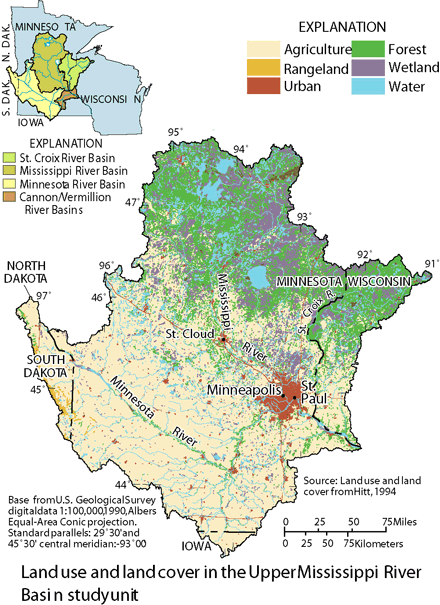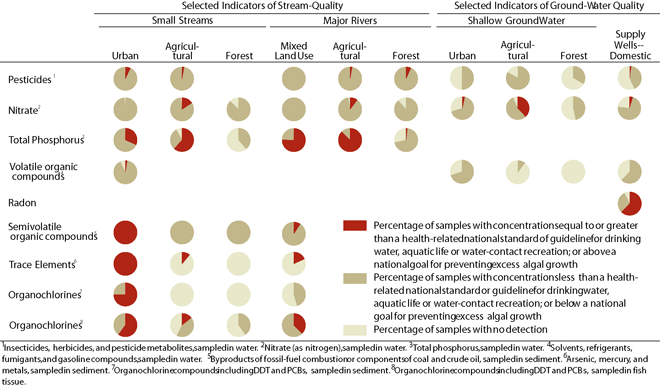SUMMARY OF MAJOR FINDINGS
The Upper Mississippi River Basin Study Unit encompasses about 47,000 mi² (square miles) in Minnesota, Wisconsin, South Dakota, Iowa, and North Dakota and includes the Twin Cities (Minneapolis and St. Paul) metropolitan area (TCMA). The three major rivers in the Study Unit are the Mississippi, the Minnesota, and the St. Croix. In 1990, about 3.7 million people resided in the Study Unit, mostly in the TCMA. The Mississippi River is the primary source of drinking water for St. Cloud, Minneapolis, and St. Paul in Minnesota. Ground water is the primary source of drinking water in rural and suburban areas.
 |
| Land use and land cover in the Upper Mississippi River Basin study unit |
Highlights of Streams and Aquatic Biology
Elevated concentrations of nutrients (nitrogen and phosphorus) in water are potentially harmful to humans, livestock, and aquatic life. Major sources of nutrients to streams are commercial fertilizers applied to crops, lawns, and gardens; wastewater discharge; leaking septic systems; snowmelt runoff; and animal manure. The total amounts of nitrate and dissolved orthophosphate were greater in streams draining agricultural areas than in streams draining areas with other land uses. Although pesticides (herbicides and insecticides) were commonly detected, most concentrations were less than current drinking-water standards and guidelines and aquatic-life guidelines; however, not all pesticides detected currently have drinking-water standards and guidelines. Samples from most streams in the Study Unit met Federal and State drinking-water standards and guidelines and aquatic-life guidelines. Invertebrate and fish communities were most degraded in urban streams.
- Nitrate concentrations in streams in artificially drained agricultural areas exceeded the U.S. Environmental Protection Agency (USEPA) drinking-water standard of 10 mg/L (milligrams per liter) in about 20 percent of the samples.
- Insecticides and nonagricultural herbicides were detected most frequently in urban areas.
- Agricultural herbicides were detected in streams throughout the Study Unit.
- Urban streams have reduced invertebrate and fish species richness and diversity compared to agricultural streams.
- Algal productivity was greater in agricultural streams than in urban and forest streams, due in part to greater concentrations of nutrients.
- Agricultural streams with wooded riparian cover had greater fish and invertebrate species richness and diversity than agricultural streams lacking wooded riparian cover.
Trends in Stream-Water Quality and Aquatic Biology
Assessing trends in water quality and aquatic biology is difficult because historical data sets are discontinuous and sampling objectives and analysis methods have varied. Some observable trends are increased nitrate concentrations, based on historical data, and decreased ammonia concentrations in streams in the TCMA during 1984–1993 primarily because of process changes at wastewater treatment facilities. Breakdown products of the pesticide DDT, the use of which was discontinued in the 1970’s, are still detectable in fish, streams, and streambed sediment.
| Major Influences on Streams and Aquatic Biology
|
Highlights of Conditions in Ground Water
Shallow ground water in the TCMA (less than 50 feet below land surface) commonly contained pesticides, nutrients, and industrial chemicals and detectable concentrations of numerous volatile organic compounds (VOCs). Deeper ground water, typically used for public supply (water supplied for the general public by municipal and private purveyors), contained few pesticides and lower nitrate concentrations. With the exception of naturally occurring radon, deeper ground water met drinking-water standards and guidelines for most chemicals.
- Nitrate concentrations in water from nearly one-half of shallow ground water sampled beneath agricultural areas exceeded the USEPA drinking-water standard (10 mg/L).
- Road salt constituents (sodium and chloride) were detected at greater concentrations in shallow ground water underlying urban areas than other areas.
- Agricultural pesticides were commonly detected in all land-use settings. Concentrations were greatest in agricultural areas.
- Atrazine was the most frequently detected agricultural pesticide. Concentrations were greater in shallow ground water than in deeper ground water.
- Prometon was the most frequently detected herbicide in urban areas.
- Ground water in the Prairie du Chien-Jordan aquifer, an important source of drinking water, is protected by overlying confining units in some areas. Concentrations of nitrate, atrazine, and VOCs were lower in these areas than where confining units were absent.
- Radon exceeded the USEPA suspended drinking water standard of 300 pCi/L (picocuries per liter) in more than one-half of the water samples from the Prairie du Chien-Jordan aquifer.
Trends in Ground-Water Quality
Temporal trends in ground-water quality are difficult to define because limited information exists. Spatial trends include greater nitrate and pesticide concentrations in agricultural areas, greater VOC concentrations in urban areas, and few detections of pesticides or VOCs in forested areas.
| Major Influences on Ground Water
|
 |
| Table of Contents || Previous Section || Next Section || Glossary U.S. Geological Survey Circular 1211 Suggested citation:
|

